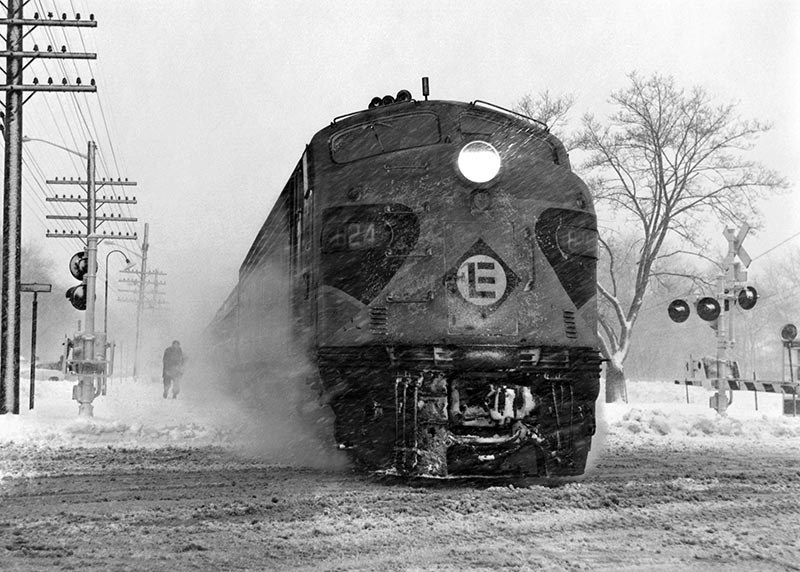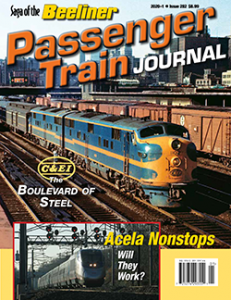 By Karl Zimmermann/photos by the author
By Karl Zimmermann/photos by the author
Though old, I’m not old enough to have experienced the era of link-and-pin coupling. Still, I know that the term “pulling the pin” is railroaders’ slang for “retiring,” which is what I’m doing from the “North American Intercity” column, though not from the magazine, at least not entirely. By the time you read this it will be 2020, a new decade by most reckonings. New year, new decade. That in my mind calls for a new voice for this column, perhaps one more in tune than mine with the realities of train travel in North America today and into the probable future. I feel written-out.
Other than the endgame you’re now holding, my final “North American Inter-city” column, “On the Old Broadway” (PTJ 2019–4) was my 53rd, in every issue of the reborn Passenger Train Journal beginning with 2006–4. Though that’s not a round number to end on, how about one hundred? That is precisely the count of features and columns I’ve contributed to PTJ, beginning with “Rerouting the CZ” in the fall 1970 issue—which happens to be roughly 50 years ago, another round number. The fledgling magazine was then in its third year of publication, on a sometimes irregular schedule. Founder Kevin McKinney was a college student of 19 when he began this prescient enterprise in the spring of 1968. The first issue was 24 pages long, composed on a typewriter, and had no photographs. They were introduced with the second issue.
That’s the first one in my oldest binder—sadly, the original PTJ isn’t there—so I guess issue two was when I became a subscriber. When I pulled that binder off the shelf last week I suddenly was no longer writing this farewell column against a deadline as I should have been but was lingering over memories from a time fraught with both nostalgia and uncertainty, as many of the great trains operated by the private railroads deteriorated, declined, and eventually disappeared, and Railpax, the flawed savior dubbed Amtrak by its May 1, 1971, inaugural was emerging. Though McKinney didn’t ignore history, advocacy was most on his mind at that critical juncture for the passenger train in America. (Anthony Haswell, founder of the National Association of Railroad Passengers, was a regular columnist.) McKinney is very much a presence at the current PTJ, and he remains an avid and articulate advocate of passenger rail in North America.
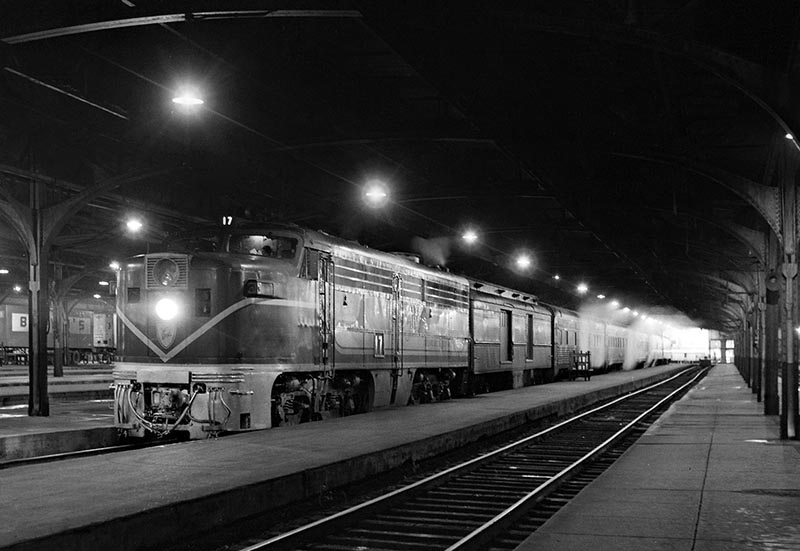
D&H’s overnight Montreal Limited is ready to leave Montreal’s Windsor Station for New York City in November 1970.
Paging through those early issues, I discovered my name for the first time in the spring 1970 issue: credits for photos of Erie Lackawanna E-units running eastbound at Tuxedo, N.Y., with the long-haul local from Port Jervis; a Penn Central United Aircraft Turbo Train near Southport, Conn.; and the City of Miami with spiffy obs car rounding a curve in Delray Beach, Fla. That era was a fulfilling and, let’s admit it, fun time to be prowling the tracks with my Rolleiflex. Seeing those pictures, from 8×0 enlargements pulled in a darkroom I shut decades ago brought back the magic of those years, the sense of youth and beginning. Even then, how-ever, more often than not photographic quests and train journeys were driven by the melancholy knowledge that much to which we were attracted was ephemeral. The prints were made with a Beseler enlarger I donated just weeks ago to a local school, definitively closing that chapter.
That “On the Old Broadway” was my one hundredth contribution to the magazine was a coincidence (as well as a harbinger of my retirement from “North American Intercity”). Another coincidence, which editor Schafer and I didn’t discover until about a decade ago, attaches to my first PTJ piece, which was about seizing the day and riding a detouring California Zephyr over Rio Grande’s Tennessee Pass line through the Royal Gorge. While Laurel and I were aboard train 17, stuck at Minturn, Colo., for some six hours behind a mudslide; Schafer and Jim Boyd (another notable future editor, of Railfan & Railroad) were trackside photographing our train. I covered this coincidence in “CZ by KZ,” my column in the 2017–1 issue.
By the time my second article “Erie Means Excellence” appeared in the fall 1973 issue, which focused on commuter operations (and marked the elimination of “PTJ” from the cover in favor of “PASSENGER TRAIN JOURNAL”), the page count was 32, the paper was slick, and the photos plentiful. My one-hundredth contribution ran in a magazine of 64 pages boasting the best paper stock and photo reproduction in its field. In between were good stories about good times. For “Trains of Note,” a feature that ran for a time in the mid-1970s, I covered the Southern Crescent, the Rio Grande Zephyr, the Silver Meteor, the North Coast Hiawatha, and the Adirondack. That New York-Montreal Delaware & Hudson daylight train and its ancestor, the Laurentian, were such favorites of mine that two years after my first coverage of the Adirondack I eulogized the loss of the elegant D&H-supplied train when it was replaced by an Amtrak Turboliner.
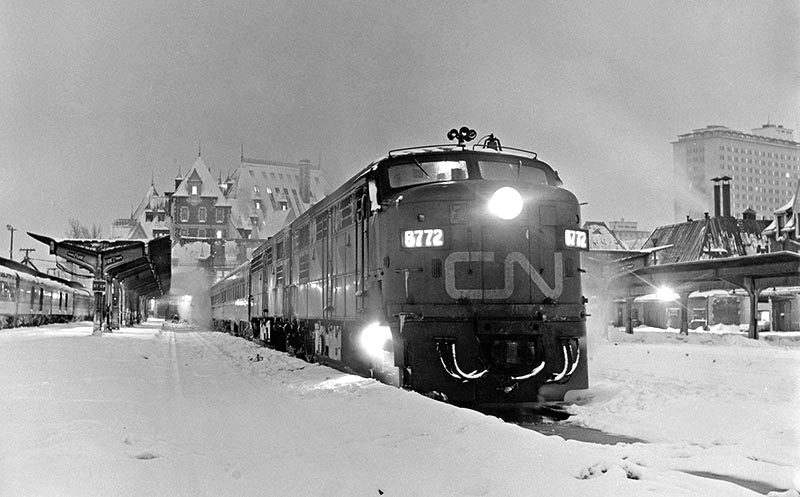
On a wintry, icy December day in 1975, with the new year close at hand, a Montreal Locomotive Works FPA/B set is ready to leave Quebec City’s Palais Station with the Rapido for Montreal.
My friendship with Mike Schafer dates to the fall of 1978 (or was it the next winter?) when we were randomly seated together at a “Railroad Roundtable” dinner at a North Shore Chicago restaurant. These gatherings of railfans, writers, and the occasional railroader were a format that came west with me from Northeastern New Jersey when Laurel and I moved to Lake Forest, Ill., with daughters Jennifer and Emily. Author, writer, and photographer Joe MacMillan was an attendee, and he brought the Railroad Roundtable west with him too, as I had, when he moved to Colorado, and it’s alive and thriving, now in its sixteenth year. The Chicago-area Roundtable still meets as well.
Kevin McKinney and I first met when he and Bill Anderson, then the general manager of PTJ, came to our house in Glen Rock, N.J. (our back yard bordered on the ex-Erie, then Erie Lackawanna Main Line and its Bergen County Line was just a block from the front yard) to rummage through my photographs for the first Passenger Train Annual, published in 1975. Erie Lackawanna was a favorite road of mine, and I often headed to its Delaware Division in quest of the vanishing F-units, but even more regularly photographed the commuter operations that surrounded me: E8s and RS-3s in the lovely scheme inherited from predecessor Lackawanna, the heavyweight no-nonsense Stillwell coaches and Budd-built streamliners that came from Santa Fe.
Through the 1970s and 1980s PTJ and I often teamed up. In mid-1978 came reports on South Africa’s Blue Train and Drakensberg, two trains of utmost elegance whose primary function was transportation. The first three months of 1980 brought a Lake Michigan railroad car ferry trilogy (ultimately collected as a book) “Red Sky at Morning for Chessie’s Boats,” “Ann Arbor Renaissance,” and “Mackinac Miracle,” about the wonderful coal-fired Chief Wawatam (a ringer perhaps, since it no longer carried passengers). A special favorite of both Schafer’s and mine was the June 1988 issue covering Henry Dreyfuss’s 1938 20th Century Limited and Raymond Loewy’s competing Broadway Limited. Read about the Broadway, then flip the magazine over and start from the back with the Century. The centerfold art by Mitch Markovitz could be enjoyed in either direction.
The “North American Intercity” column has been a cozy home for me for thirteen years (lucky rather than unlucky), and the editor has been gracious in allowing me to stretch its permissible bounds. From the beginning I assumed that hard news in my area was covered elsewhere in the magazine: the editor’s “On the Point” (a splendid double entendre) and the “Journal” for starters, so I felt free to roam. For the fourth issue, for instance, I visited Michael Schwab at his studio in San Anselmo, in the San Francisco Bay Area. Schwab’s wonderful retro posters, banners, and menu covers evoked the Art Deco era when passenger trains were the newest, greatest thing, and I was eager to meet him. In PTJ 2015-3 I discussed the revival of the musical “On the 20th Century” and the 1938 train it depicted, comparing it with Amtrak’s contemporary offerings. (In the November 1978 issue I’d reviewed the original production.)
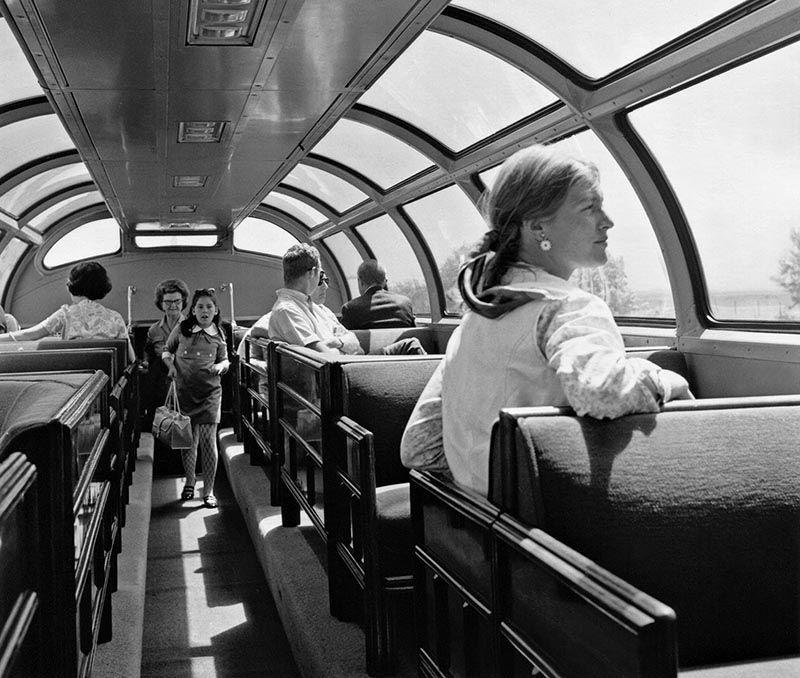
It’s August 26, 1969, and Laurel and I are Los Angeles-bound from San Francisco on Southern Pacific’s Coast Daylight. Though low profile, this home-built dome offered an elegant cocktail lounge with wood-trimmed loveseats. Laurel has always been my best model.
 I settled in so comfortably, and hoped my column’s readers had too, that at some point my wife became just “Laurel,” not “my wife, Laurel.” In issue 2017-1 my mug shot changed to reflect reality. The early middle-aged train rider, sort of an aging preppy in tie and blue blazer, gave way to reality: a bearded old guy with open collar, a reflection of both his evolution and society’s.
I settled in so comfortably, and hoped my column’s readers had too, that at some point my wife became just “Laurel,” not “my wife, Laurel.” In issue 2017-1 my mug shot changed to reflect reality. The early middle-aged train rider, sort of an aging preppy in tie and blue blazer, gave way to reality: a bearded old guy with open collar, a reflection of both his evolution and society’s.
“All I know is what I read in the papers.” That somewhat coy assertion was made famous by humorist Will Rogers, who used it to begin his monologues, and I’ll borrow it to finish up here by pondering the state of passenger railroading in North America as I sign off from that beat. So what do I read? I read of Amtrak President and CEO Richard Anderson taking a victory lap for bringing Amtrak closer to breaking even than ever before in its nearly half-century-long history and predicting break-even will happen by next summer—“not counting,” as a laudatory Wall Street Journal piece says, “the significant amounts it spends maintaining trains, tracks, and tunnels.” This is no doubt an accomplishment that might make me happy but doesn’t entirely, since in my opinion Amtrak’s goals should include getting people off the highways and out of the air onto a more energy efficient and environmentally preferable mode of travel.
How has the cost-saving necessary for this been accomplished? Largely by eliminating personnel, witness the numerous stations that have lost their agents. Another high-profile cost-saver is reducing food-service staffing on Eastern trains to a single person (not that it’s generous on Western trains), casting the passenger in the role of server. The previous issue of PTJ covered the Amtrak dining situation in depth. ‘Nuff said, though from a different slant food service will emerge again briefly before I finish this farewell.
I’ve also been reading about “flight shame,” flygskam in Swedish, and Sweden is where it comes from, as does Greta Thunberg, the teenage climate activist recently on the cover of Time as Person of the Year. Flight-shaming may be too woke for many PTJ readers, and lots of well-intentioned people (I among them) haven’t given up flying entirely, but how about the reciprocal Swedish concept: tagskryt, or “train boasting”? Perhaps that’s easier to embrace. Environmental benefit strikes me as a selling point that, as far as I know, Amtrak has ignored. (VIA has done better.) But perhaps it would be hard for a quasi-governmental corporation that wraps up mountains of unsorted trash from food-service cars every day to be dumped into landfills to tout environmental responsibility. Even Delta, Anderson’s former employer, does some recycling.
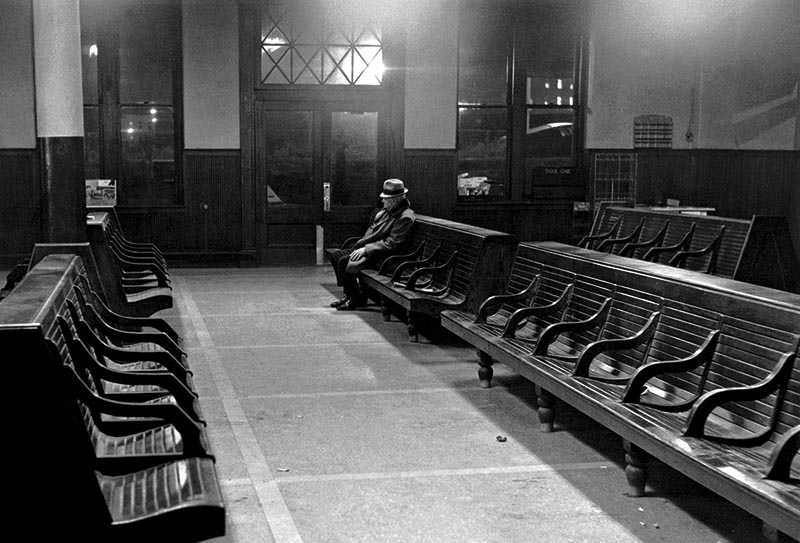
This lonely figure in the waiting room of Erie Lackawanna’s former DL&W depot in Binghamton, N.Y., speaks volumes about sad times for passenger railroading in the run up to Amtrak.
The “European Green Deal” is a real thing, not a subject of mockery, and the Community of European Railway & Infrastructure Companies, analogous to our Association of American Railroads, is fully on board. Germany, for instance, has committed to spending the equivalent of $176 billion over the next decade on rail improvements. I also read in the papers about Nightjet, not an airline but the burgeoning new overnight service on Austria’s federal railway. It appears that, at least in a small way, over-night sleeping-car services are making a comeback in Europe while they’re apparently unloved by Amtrak. Nightjet tickets carry information about the journey’s reduced carbon footprint com-pared to other modes. Amtrak could do the same, and maybe it will. And I’ll be around to see if it does, since PTJ has offered to keep me on the masthead for occasional contributions as Editor-at-Large, further legitimizing the broader purview I’ve always enjoyed.
In recent years I’ve lamented most everything Amtrak has done: no more printed timetables, route guides (not even online; inexcusable), newspapers delivered to sleeping-car rooms in the morning. (I know, I know, in this world of devices, who needs a printed paper?) Private-car movements made more difficult and expensive, and even if you can afford it no standing or sitting on the rear observation platform. Dining-car amenities slashed, even in the West, the only place true dining cars survive at all. No more crockery, glassware, table flowers, regional or train-specific menus. No more Pacific Parlour Car. Thus I list my grievances one last time, and I’m done.
“Flexible Dining” on the Eastern trains Amtrak explains as stemming from millennials being uncomfortable eating with strangers (for many of us that is a charm of traditional railway dining) and preferring inter-acting with their devices, and maybe that’s true, and not just a smoke screen to conceal the real motive: cost-cutting. “The times they are a-changin’,” Bob Dylan wrote ages ago, and that’s never been more true than now, but I’m not a-changing so much, and that’s a problem. For instance, unlike many of those around me, I don’t always have my iPhone at the ready—just a fact, not a boast.
Much as I try, I can’t fully erase from memory the rail travel standards I first knew, though they’re not a relevant benchmark today. And sad as Amtrak food service now is, I just needed to re-read “Doomed Diners,” my coverage in the November 1981 PTJ of tray food and plastic utensils, to feel at least a little better about contemporary rail dining.
Done with complaining, I pass the baton. Happy New Year! Let’s all hope for the best and, like me, look forward to an-other train journey.


